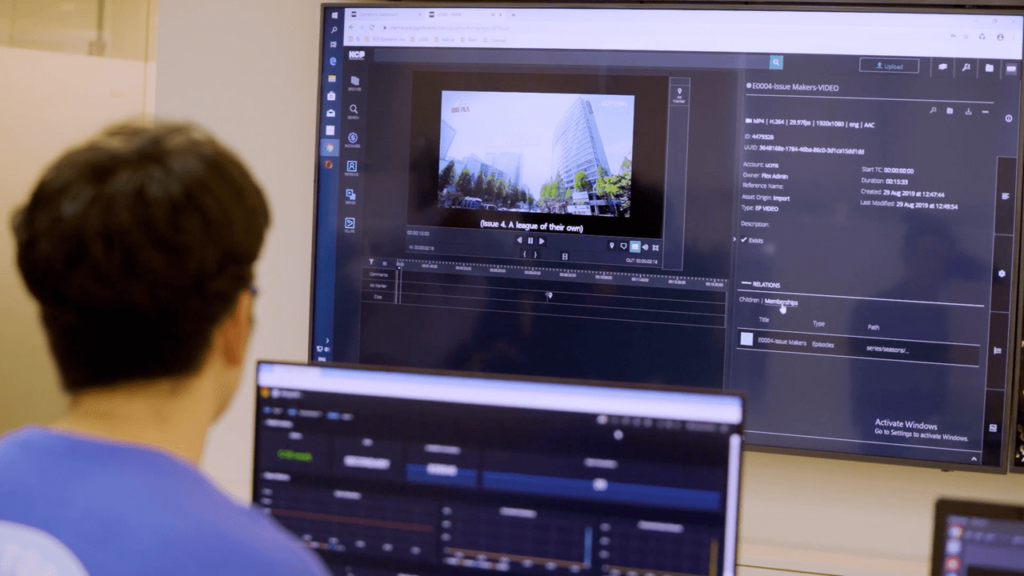No matter your niche, you’ve likely heard endless noise about the proliferation and importance of cloud technology. Though talk of the cloud’s seismic impact has become cliche, it really is driving huge shifts in capability across many industries — and media asset management (MAM) is no exception.
Media-focused businesses large and small are already reaping serious rewards from the integration of video archive systems with the cloud. These benefits go beyond simple cost savings and increased efficiency.
However, moving to the cloud is no easy feat. Whether you’re implementing a hybrid approach or looking to shift to a fully cloud-native solution, it’s important to follow a robust methodology. Enlisting the help of a partner who knows your business inside out and can provide the services you require is integral.
In this post, we explore the benefits of migrating your MAM to the cloud and outline how we as a business successfully implement such systems. But before that, let’s define what a cloud based Media Asset Management actually is.
What is a Cloud based Media Asset Management?
At its core, a cloud based Media Asset Management solution uses cloud services to store and serve content from media libraries as part of the production and distribution process.
However, in reality, “cloud-based” can have multiple meanings. It could refer to fully hosted solutions where every aspect of MAM is managed by a cloud provider. It may also refer to hybrid models, where certain elements remain on-premises while others are moved to the cloud.
It’s important to recognize that cloud based media asset management does not mean cloud-native MAM. At Dalet, we define a true cloud Media Asset Management system as an enterprise solution built with cloud-native architecture, made up of microservices and modular capabilities.
Key features of a cloud-native MAM include:
- Unified Content Catalog: where disparate media libraries are brought together into easy-to-access cloud storage.
- Workflow Orchestration and Automation: where standard and custom workflows are leveraged alongside AI technology to transcode, approve, publish, and more.
- Application Ecosystem: where a suite of cloud-native tools is curated to address the specific technical and editorial needs of an individual media business.
Are you overwhelmed by your extensive media library ? Our customers experience unmatched scalability with our Cloud-native MAM, designed to grow with your business seamlessly. Request Your Personalised MAM Demo Today!
Can a Cloud based Media Asset Management Coexist with an On-premises Solution?

Regardless of your architecture, a cloud based Media Asset Management does not have to exclusively use cloud storage. It can integrate with multiple cloud providers and on-premise storage to operate in a hybrid model.
Traditionally, the moving of a MAM to the cloud may have been contextualized as a classic “lift and shift.” In other words, the moving of on-premises, physical server-based storage to a virtual cloud-based archive.
While lift and shift options bring the accessibility of the cloud and remove on-premise infrastructure needs, they do not take full advantage of the cloud in the same way cloud-native architecture does.
What Services and Workflows Does a Cloud-Native MAM Impact?
While many lightweight web-based solutions exist, they lack the power of a cloud-native MAM capable of improving access, collaboration, and efficiency on an industrial scale, based on user needs.
While all features might not all be used across every implementation, an enterprise cloud-native MAM system will be comprised of several key technical components:
- Cloud Storage: This is the backbone of a cloud-native MAM, providing scalable, secure, and cost-effective storage solutions for media assets across multiple storage tiers.
- Intelligent Ingest – Ingest any media with relevant and enhanced technical and editorial metadata at scale regardless of where the media originates from, for example, watch folders, camera cards, live feeds (SDI, SMPTE IP, compressed IP), or file uploads.
- Metadata Management: Essential for organizing, searching, and managing video files effectively. Cloud facilitates metadata capabilities through advanced tagging and indexing.
- Workflow Engine & Automation – In-house ability to quickly create workflows that efficiently distribute content at every stage of the media supply chain ensuring secure, reliable access to assets
- Transcoding and Encoding Services: Cloud services can automatically convert media files into various formats and resolutions, making them suitable for different distribution channels and devices.
- Integration APIs – These allow for seamless integration with other tools and systems such as NLEs, file transfer systems, AQCs, playout, monetization, analytics platforms, and more.
What are the Benefits of Implementing a Cloud-Native MAM System?
Following a successful migration, the benefits of implementing a cloud-native MAM system are numerous:
- Scalability: The cloud allows you to easily dynamically scale your storage and processing needs up or down without significant upfront investment.
- Accessibility: Users can access media assets from anywhere, at any time. Previously, clunky VPNs and high-speed internet connections may have been required to access media assets. With cloud a standard wi-fi connection is all that’s needed.
- Improved Workflows: Automation makes it easy to orchestrate your media supply chain and manage your storage costs. You can control where files are and when they are accessible. Metadata can also be used to determine when files are moved to and from cold storage, based on the specific needs of your operation.
- Cost Efficiency: Cloud reduces the total cost of ownership by removing the need for physical infrastructure and the associated maintenance costs, while improving your content security.
- Security: Cloud-native MAM systems leverage cloud provider security measures, including data encryption and secure multi-factor access controls.
- Content Monetization: Return on investment extends beyond financial savings. Cloud-native systems allow you to generate new revenue streams by licensing selected inventory to clients, partners and affiliates through integrations with modern digital storefronts.
- Innovation: Cloud-native architecture allows you to quickly adopt new features and technologies as they become available in the cloud ecosystem.
- Reliability: Cloud systems can take advantage of providers’ immense scale. No matter where you are in the world, you’ll always be near to a server location for quick, reliable access to archives. Cloud also removes barriers to high availability – AWS operates a “five nines” principle of 99.999% year-round availability and uptime.
- Energy Savings: Cloud data centers are up to 5x more energy-efficient than traditional data centers, reducing energy costs for companies that migrate to the cloud.

How Long Does It Take to See Benefits from Cloud-Native MAM?
The timeline to realize these benefits can vary. Typically, organizations begin to see improvements in operational efficiency and cost savings within the first few months after implementation. However, the full scope of benefits, especially those related to strategic advantages like improved content distribution and market responsiveness, may take longer to materialize.
But an uptick in performance can come quickly. When our customer France Télévisions was faced with a nationwide lockdown in March 2020, staff had no direct access to the company’s systems. We were able to rapidly implement remote cloud workflow solutions and restore operational strength in just 4 weeks.
Preparing to Move to The Cloud
Whether you’ve decided to move all or part of your MAM system to the cloud, there are several things to consider. Moving to the cloud is a big task — one that nobody wants to have to do twice — so it’s important to make the right choices.
Before any implementation, it’s important that your MAM provider has a holistic understanding of your business. This involves understanding your business’ current MAM setup and workflows, exploring how you operate with other vendors, and determining your needs and ambitions moving forward.
Moving to the cloud isn’t about having the latest and greatest, it’s about bringing real value to your operation and enabling you to achieve sustainable growth.
While all media-focused businesses are likely to benefit from the features we’ve already listed, your organization will have specific pain points that a cloud MAM can ease. It’s important to state clear aims and objectives.
If you’re a broadcaster, the aim may be to drastically improve the speed and efficiency of content delivery to meet tight deadlines. In the film industry, the focus might be on collaboration among geographically dispersed post-production teams. Setting the precise specifications for the cloud features you want to exploit is key.
Over the past 33 years, we’ve built significant experience in managing large-scale, multi-million-dollar projects. Over this time, we’ve created a set of standardized tools and methodologies to ensure the successful delivery of our projects.

Key Milestones for Successful Cloud-Native MAM Implementation
Though this varies depending on the nature of the project, our phased implementation approach typically includes:
- Project Initialization & Scope: working with you to define the scope of the project by setting high-level goals and objectives.
- Business Analysis Requirements: performing a study to determine the functional requirements of the desired system. This study includes an in-depth analysis of workflow, infrastructure, interoperability with third-party systems, and data migration from legacy systems.
- Project Planning & Design: writing a plan with detailed descriptions of key milestones throughout the project to ensure delivery is on time and within budget.
- Risk Management: anticipating risks and developing workarounds as needed.
Integration & Customization Engineering: providing customization for integration with third-party applications, databases, legacy systems, or equipment – in other words, connecting to the tools your business already uses. - Implementation & Configuration: working with you and third parties to implement and configure the system in accordance with the requirements.
- Acceptance Testing: planning and conducting acceptance test scenarios to verify that the implemented solution meets the desired system requirements.
- Training and Coaching: providing custom training sessions to both technical and non-technical audiences.
- Roll out: working with your organization to develop a proper support strategy, organize post-project evolution, and evaluate any future needs.
Initialization in Practice
So, what does this actually look like in practice?
Following kick-off, our Professional Services team will engage with relevant stakeholders in your business on an agile basis, working across a series of project sprints that typically last for 3 weeks at a time.
This outlines a simplified migration from on-premises to the cloud. In reality, businesses often deploy a hybrid approach or gradually move to the cloud in iterations over time.
| Sprint | Purpose |
|---|---|
| Project Initiation | To define and agree on the project methodology and governance. |
| Sprint 1: High-level Requirements | To agree on the design requirements for the solution and specifications for key workflows. Based on these requirements, the necessary design and build documentation is produced. |
| Sprint 2: Basic Installation | To deploy the MAM media platform on the agreed infrastructure and configure basic workflows. |
| Sprint 3: Metadata Model | To define the metadata model which is configured by engineers to specification before testing and validation. |
| Sprint 4: Ingest Workflow | To specify the ingest workflow based on the requirements captured, before being configured, tested, and validated. |
| Sprint 5: Editing Workflow | To specify the editing workflow based on the requirements, before configuring the platform and required integrations with the non-linear editing (NLE) process. |
| Sprint 6: Publication/Distribution Workflow | To specify the publication/distribution workflow, before configuring the platform and the required integrations. |
| Sprint 7: Migration | To agree on the migration methodology and execute the migration process before testing and validation. This process can take up to 6 weeks depending on the volume of data to be migrated. |
| Sprint 8: Final Acceptance | To conduct tests to confirm that the implementation conforms to the high-level design specifications and the specifications of each sprint. |
| Training | To deliver training to the customer super users and administrator. Oftentimes some or all of these sessions will be delivered before the project’s go-live date. |
| Project Closure | To agree to the signed-off completion of all project activities. Dalet provides on-site coverage while the system goes into production. |
Dalet’s distributed architecture means files can reside anywhere at any time, with the benefits of cloud felt even when some files remain in on-premises storage.
The Key to a Successful Setup Process
Whether implementing a hybrid or full cloud-native solution, some areas of the initialization are particularly important to get right.
Defining accurate technical specifications, including infrastructure, security, and storage requirements, is crucial. A consultant or cloud services operations specialist will take extra care in pulling together requirements. This person then becomes ultimately responsible for successful deployment on the appropriate cloud account.
We support integration with many providers, including AWS, Azure, Google, Alibaba, OVH and more. This is important to us, not only in terms of increasing consumer choice but also from a data recovery standpoint. Some customers house their entire media library with one provider. Dalet Flex mirrors this data with another provider as well, for extra security.

Security measures are integral. We provide recommendations for ports, services, anti-virus measures, and more. This may involve discussions about VPNs and secure data transfers, especially between cloud and on-premise locations, ensuring a secure environment.
When it comes to migration, specifications cover the movement of data from existing systems, possibly involving third-party solutions. The approach will vary depending on the media business in question. A move to the cloud might require the use of technologies like AWS Snowball for data transfer. It’s also common to deal with specific requests for data context preservation. This stage is one of the most complex and crucial, as it involves ensuring that existing data is accurately and efficiently migrated to the new system, considering all technical and functional requirements.
In the Long Term: How MAM Is Set to Evolve
Looking ahead, cloud-native MAM is set to become even more integral to media production and distribution workflows. Advances in AI and machine learning will further enhance metadata management and content personalization. Cloud providers will continue to improve security, compliance, and global reach, making cloud-native MAM an even more attractive option for media-focused businesses.
The evolution of cloud-native MAM is tied to the broader trends in cloud technology and media consumption habits such as a prevalence of mobile video and streaming. As the media landscape evolves, cloud-native MAM systems will become more sophisticated, enabling media companies to not only manage their assets more effectively but also to innovate and adapt to the change.
In order to make the most of these advancements, many businesses will need to update their approach towards collaboration. At Dalet, we believe that organizations should reimagine and reorganize how they work to maximize impact on operations and productivity. Our co-founder Stephane Guez provides more context in his post Media Trends of 2024: Big Events and Big Changes.
Ready to Realize the Benefits of The Cloud?
Implementing a cloud-native MAM successfully requires careful planning, a clear understanding of your organization’s needs, and a strategic approach to integration. The benefits of making the transition are clear, offering significant advantages in terms of cost, efficiency, and scalability, but it’s difficult to achieve all of this without the right partner.
If you’re keen to hear more information about Dalet’s cloud-native MAM services or are looking for help with your business own migration to the cloud, get in touch with a Dalet representative today.
Get expert guidance
Featured in: Cloud | cloud storage | cloud-based mam | cloud-based media asset management | cloud-native mam | Digital Media Assets | mam system | Media Asset Management | media files | Metadata | Transcoding |
Aaron is the product marketing lead for Dalet, a leading technology and service provider for media-rich organizations. Aaron is spearheading go-to-market initiatives around cloud-native media supply chain and production workflows, revolutionizing enterprise media operations worldwide.
More Articles By Aaron



